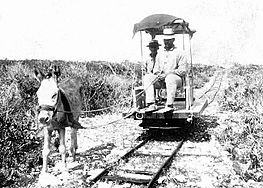Mona Island Light facts for kids
 |
|
| Location | Mona Island, Mayagüez, Puerto Rico |
|---|---|
| Coordinates | 18°5′5.2″N 67°51′4.4″W / 18.084778°N 67.851222°W |
| Year first lit | 1900 |
| Automated | 1973 |
| Deactivated | 1976 |
| Foundation | Concrete |
| Construction | Iron |
| Tower shape | Skeletal with central cylinder |
| Markings / pattern | Black |
| Original lens | Second-order Fresnel |
The Mona Island Light, also called Faro de la Isla de la Mona, is a historic lighthouse. It stands on Mona Island. This island is located in the Mona Passage, which is between Puerto Rico and the Dominican Republic. This lighthouse is special because it is the only one in Puerto Rico built from iron and steel.
Some people thought the famous engineer Gustav Eiffel designed it. He also designed the Eiffel Tower in Paris. However, newer studies show that Spanish engineer Rafael Ravena designed the tower around 1885.
This lighthouse was the first of two lighthouses built by the U.S. government in Puerto Rico. It first shone its light in 1900. In 1973, it became automated, meaning it worked by itself. The light was turned off in 1976. A newer, more modern light replaced it. Since then, the lighthouse has become quite old and rusty. It is even listed as one of "500 Places to See Before They Disappear."
Contents
History of the Mona Island Lighthouse
Spanish engineer Rafael Ravena drew up plans for a lighthouse on Mona Island. He made two sets of plans between 1885 and 1886. The lighthouse was needed to help ships navigate the Mona Passage. This passage is a busy shipping route.
One plan was for a very large stone building. It would have had 25 rooms for three lighthouse keepers, their families, and supplies. Its light would have shone for 22 miles. However, this plan was not used. This was probably because the island's sandstone was too soft and crumbly.
The second plan was for an iron tower. It would have had a separate living area for one keeper and his family. This plan was approved in 1887. Work on building the lighthouse started in the early 1890s. The parts for the lighthouse were made in France by a company called Duclos & Cie. After the Spanish–American War in 1898, the U.S. government took over and finished building it.
The Mona Island Railway
The Mona Island Light needed a way to get supplies from the beach up to the lighthouse. A narrow-gauge railway was built for this purpose. It was about 1.1 miles (1.8 kilometers) long. The railway had a special incline that went from the beach into a cave.
Supplies were carried through the cave. Then, a donkey pulled a wagon along a 6,000-foot (1,800-meter) long track. This track led all the way to the lighthouse. The donkey even had a canopy over its wagon to protect it from the sun!
National Register of Historic Places
The Mona Island Light is very important. Because of its history and unique design, it was added to the U.S. National Register of Historic Places in 1981. It is listed as "Faro de la Isla de la Mona."
See also
 In Spanish: Faro de la Isla de Mona para niños
In Spanish: Faro de la Isla de Mona para niños




